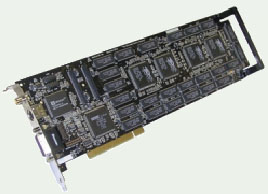Voodoo 2

Time passed, and the second generation of 3D accelerators was waiting for its turn. But what was needed was a chip that would mark the beginning of the second generation. Voodoo2 was such a chip.
Leaving aside HI-END accelerators, we can say that all 3D chips before the advent of Voodoo2 were a "bottleneck" in the graphics system. The processor was more than enough to load the video card with data and process something else. With the advent of Voodoo2, the situation has changed. Thanks to its improved architecture and faster fillrate, the Voodoo2 outperformed all other components in the system, and now, for the first time, the processor has become the "bottleneck" of a computer. The system requirements of Voodoo2 accelerators indicated Pentium2. To feel the difference in speed between 640x480 and 800x600 resolutions, you need to use P2-266, and if you turn on two Voodoo2s in SLI mode, then P2-350 was not enough.
Features Voodoo 2
| type |
3D |
| Technology | 0.35 Micron |
| Throughput |
3 mPolys/sec |
| Fillrate | 90 mPix./sec (180 mPix./sec in SLI mode) |
| API | DirectX 5.0 / Glide / OpenGL |
| OpenGL | MCD |
| RAMDAC | 175 |
| Memory | Up to 12 Mb (Up to 24 Mb in SLI Mode) |
| memory type | EDO DRAM |
| Z-Buffer | 16-bit integer |
| Max 3D resolution | 800x600(Single) 1024x768(SLI Mode) |
| 32-bit rendering | No |
Voodoo2 is a set of at least three chips - two TMUs and one FBI. Due to the use of two texture modules, multitexturing becomes possible - the imposition of two textures on one pixel per clock. Voodoo2 operates at 90 MHz. It follows that the fill rate is 90 Mpixels/sec. No multitexturing.
The maximum processing speed is 3,000,000 polygons per second. As you can see, the stock is large. Enough so that the fastest processor at that time could not fully load the accelerator.
The improved architecture made it possible to achieve video memory bandwidths of 2.2 Gb/s.
Display speed - 90 MPixels/sec without multitexturing and 180 MPixels/sec in multitexturing mode. This speed is more than enough to work in resolutions up to 1024x768.
Thanks to the support of multitexturing, the BumpMapping function became possible. BumpMapping's single-pass execution was sure to raise the quality of Voodoo2-based games to a whole new level.
Like Voodoo Graphics, Voodoo2 connects to a 2D graphics card using Pass-Through connectors.
Support up to 12MB EDO DRAM. 175 MHz RAMDAC improved the image quality and allowed setting an acceptable frame rate up to 1024x768 resolution. The
Voodoo2 chip implemented trilinear filtering.
This greatly improved the quality of the output image. Now quality claims could be forgotten if it weren't for 16-bit color.
Support for 16-bit color only. A flaw that 3dfx was simply unwilling to fix.
SLI - Almost all Voodoo2 accelerators had an additional connector on the board. A cable was connected to this connector, resembling an IDE cable, which connected two identical Voodoo2 boards. When using two Voodoo2s in SLI mode, the user got the following benefits: 24 MB of video memory (if two 12 MB boards are used), 1024x768 resolution with hardware z-buffer became available, speed increase by about 1.7 times.
According to Voodoo2, we can draw the following conclusions: the absolute champion of its time. Voodoo2 accelerators were initially overpriced, but they were worth it. Support for OpenGL only through miniports, lack of support for large textures and 32-bit color are definitely disadvantages.



